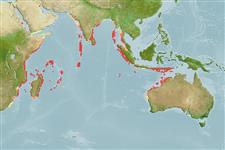Teleostei (teleosts) >
Eupercaria/misc (Various families in series Eupercaria) >
Scaridae (Parrotfishes) > Scarinae
Etymology: Chlorurus: Greek, chloros = green + Greek oura = tail (Ref. 45335).
More on author: Lacepède.
Environment: milieu / climate zone / depth range / distribution range
Ecology
Marine; reef-associated; non-migratory; depth range 1 - 7 m (Ref. 90102). Tropical
Western Indian Ocean: known so far from Mozambique, Mauritius, Chagos Archipelago, and Maldives. Recently recorded from Reunion (Ref. 53568). Probably more widespread.
Size / Weight / Age
Maturity: Lm ? range ? - ? cm
Max length : 50.0 cm TL male/unsexed; (Ref. 9710)
Found on shallow fringing reefs. Usually in areas with dead coral and rubble (Ref. 9710). Forms small groups (Ref. 90102). Feeds on benthic algae. Also caught with nets and other kinds of artisanal gear. Mainly sold fresh.
Life cycle and mating behavior
Maturity | Reproduction | Spawning | Eggs | Fecundity | Larvae
Oviparous, distinct pairing during breeding (Ref. 205).
Randall, J.E., 1986. Scaridae. p. 706-714. In M.M. Smith and P.C. Heemstra (eds.) Smiths' sea fishes. Springer-Verlag, Berlin. (Ref. 5490)
IUCN Red List Status (Ref. 130435: Version 2024-2)
Threat to humans
Harmless
Human uses
Fisheries: commercial
Tools
Special reports
Download XML
Internet sources
Estimates based on models
Preferred temperature (Ref.
123201): 25.6 - 29.3, mean 28.1 °C (based on 800 cells).
Phylogenetic diversity index (Ref.
82804): PD
50 = 0.5000 [Uniqueness, from 0.5 = low to 2.0 = high].
Bayesian length-weight: a=0.01380 (0.00650 - 0.02933), b=3.03 (2.85 - 3.21), in cm total length, based on LWR estimates for this (Sub)family-body shape (Ref.
93245).
Trophic level (Ref.
69278): 2.0 ±0.00 se; based on food items.
Resilience (Ref.
120179): Medium, minimum population doubling time 1.4 - 4.4 years (Preliminary K or Fecundity.).
Fishing Vulnerability (Ref.
59153): Moderate vulnerability (40 of 100).
Nutrients (Ref.
124155): Calcium = 31.7 [12.8, 104.7] mg/100g; Iron = 0.573 [0.224, 1.479] mg/100g; Protein = 18.7 [16.6, 20.6] %; Omega3 = 0.0768 [, ] g/100g; Selenium = 27.2 [9.1, 84.2] μg/100g; VitaminA = 47.3 [13.7, 157.0] μg/100g; Zinc = 2.13 [0.96, 3.88] mg/100g (wet weight);
